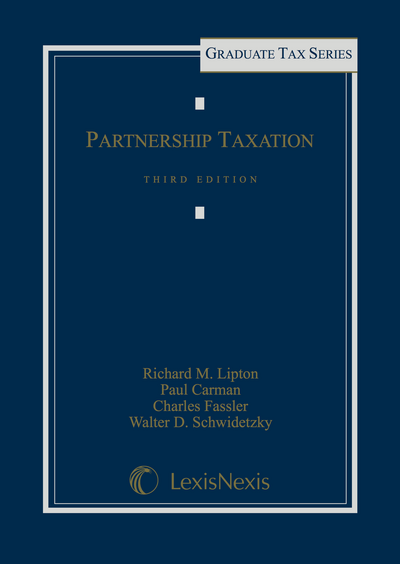This title has been replaced by a newer edition:
Partnership Taxation, Fourth Edition
2017, 546 pp, casebound, ISBN 978-1-5310-0539-9
$187.00
Teacher's Manual available
Partnership Taxation
Third Edition
by Richard Lipton, Paul Carman, Charles Fassler, Walter D. Schwidetzky
2012
Tags: Graduate Tax Series and Taxation
Teacher's Manual available
494 pp $187.00
ISBN 978-0-76984-903-4
eISBN 978-0-32717-619-0
View or download the free 2016 Online Supplement for this product.
Partnership Taxation is one of several releases from the LexisNexis Graduate Tax Series. This book contains a thorough discussion of the rules of partnership taxation — when a partnership exists, the tax treatment of contributions to a partnership, the basis of partnership assets and interests in a partnership, how income is allocated to the partners, the tax treatment of distributions, the consequences of partnership liabilities, partnership mergers, the retirement of a partner and dissolution of the partnership. There is also significant attention paid to the numerous "anti-abuse" rules that have been adopted by Congress and the IRS over the past several decades, including the disguised sale rules, the treatment of "mixing-bowl" transactions, the complex rules to prevent basis abuse, and the overriding "partnership anti-abuse regulations" adopted by the IRS. In addition, this book explores one of the fundamental questions that always arises in partnership taxation: Is a partnership to be treated as a separate taxable entity or an aggregate of its partners? The tension between entity and aggregate treatment of a partnership is one of the recurring issues in determining the tax consequences of partnership transactions. In addition to bringing the book up-to-date with the latest tax law changes and expansion of several chapters, the Third Edition contains new chapters on family partnerships, the death of a partner, and S corporations. It provides an extended discussion of allocation methods that do not have substantial economic effect, but are designed to be in accordance with the partners' interests in the partnership; series LLCs and their recently proposed regulations are also discussed in detail. The text is now suitable for both a "basic" partnership tax course (if partnership tax can ever be thought of as basic), as well as an "advanced" partnership tax course. The Teacher's Manual provides suggested syllabi for both courses.



